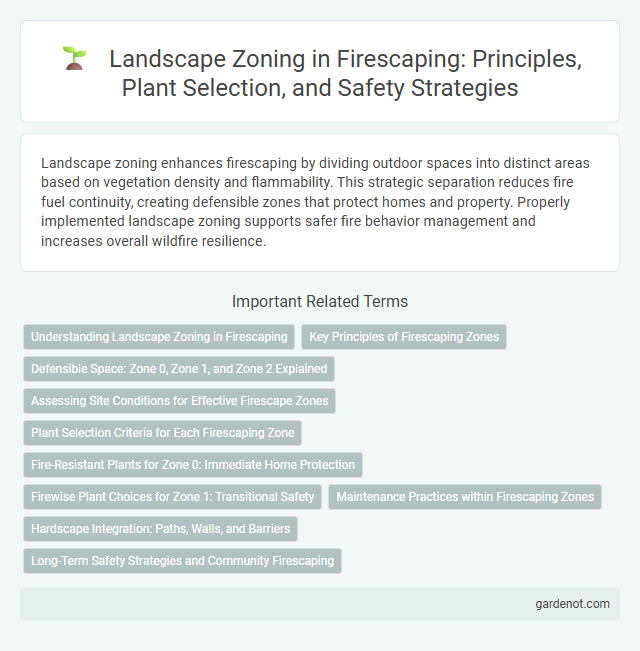Landscape zoning enhances firescaping by dividing outdoor spaces into distinct areas based on vegetation density and flammability. This strategic separation reduces fire fuel continuity, creating defensible zones that protect homes and property. Properly implemented landscape zoning supports safer fire behavior management and increases overall wildfire resilience.
Understanding Landscape Zoning in Firescaping
Landscape zoning in firescaping involves strategically dividing outdoor areas into distinct zones based on fire risk and vegetation type to reduce wildfire hazards. Proper zoning prioritizes the creation of defensible space by incorporating fire-resistant plants, maintaining clear separation between flammable materials, and managing fuel loads within each zone. This approach enhances property protection by controlling fire spread pathways and facilitating safer evacuation routes.
Key Principles of Firescaping Zones
Firescaping zones divide a property into distinct areas based on their proximity to a structure, with Zone 1 typically encompassing the immediate 30-foot perimeter where fire-resistant plants and non-combustible materials are essential. Zone 2 extends from 30 to 100 feet, focusing on reducing fuel by thinning trees and clearing dead vegetation to slow fire spread. Implementing these key zones adheres to principles of creating defensible space, minimizing continuous vegetation, and maintaining moisture levels to enhance wildfire resilience.
Defensible Space: Zone 0, Zone 1, and Zone 2 Explained
Defensible space in firescaping is divided into three critical zones designed to reduce wildfire risk: Zone 0, the area immediately surrounding the home, should be cleared of flammable vegetation and materials within 5 feet to prevent ember ignition; Zone 1 extends 5 to 30 feet from the structure and requires low-growing, well-maintained plants with adequate spacing to create a fuel break; Zone 2, spanning 30 to 100 feet, consists of thinned vegetation and maintained trees to reduce radiant heat and slow fire spread, enhancing overall property protection.
Assessing Site Conditions for Effective Firescape Zones
Assessing site conditions is crucial for effective firescape zones, involving detailed analysis of topography, vegetation types, and local climate patterns to determine fire behavior risks. Evaluating slope steepness and aspect helps predict fire spread direction and intensity, while identifying plant species with varying flammability guides vegetation management. Soil moisture and prevailing wind data further optimize the design of defensible spaces, enhancing landscape zoning strategies to minimize fire impact.
Plant Selection Criteria for Each Firescaping Zone
Plant selection for firescaping zones prioritizes species with low flammability characteristics such as high moisture content, minimal resin or oil presence, and low dead material accumulation. In high-risk zones closest to structures, use fire-resistant plants like succulents, deciduous trees, and well-irrigated, fire-retardant shrubs that create defensible space. Outer zones allow more fire-tolerant vegetation but still benefit from strategic spacing and pruning to reduce fuel continuity and slow fire spread.
Fire-Resistant Plants for Zone 0: Immediate Home Protection
Zone 0 of firescaping requires planting fire-resistant species such as aloe, sedum, and agave to create a defensible space immediately adjacent to the home. These succulents contain high moisture content, reducing flammability and acting as natural fire barriers. Proper maintenance, including regular irrigation and debris removal, enhances their effectiveness in protecting structures from wildfire encroachment.
Firewise Plant Choices for Zone 1: Transitional Safety
Zone 1 in firescaping, known as the Transitional Safety zone, requires strategic Firewise plant choices to reduce fire risk near structures. Select low-flammability plants such as succulents, deciduous shrubs, and herbaceous perennials with high moisture content that resist ignition. Maintaining adequate spacing, regularly removing dead vegetation, and avoiding resinous or oily plants enhances defensibility and protects homes from wildfire exposure.
Maintenance Practices within Firescaping Zones
Effective maintenance practices within firescaping zones involve regular removal of dead vegetation, pruning of trees and shrubs to reduce canopy density, and consistent irrigation to maintain plant health and moisture levels. Strategic zoning categorizes areas into high, moderate, and low fire risk, enabling tailored maintenance schedules that prioritize fuel reduction in high-risk zones. Utilizing fire-resistant plant species and maintaining clear defensible spaces around structures enhances overall landscape resilience against wildfire threats.
Hardscape Integration: Paths, Walls, and Barriers
Hardscape integration in firescaping involves strategically designing paths, walls, and barriers to create defensible spaces that slow wildfire spread and enhance safety. Durable materials such as stone, brick, and concrete are used to construct fire-resistant walkways and retaining walls that act as effective fuel breaks. Proper placement and maintenance of these hardscape elements contribute to minimizing combustible vegetation near structures and guiding emergency access routes efficiently.
Long-Term Safety Strategies and Community Firescaping
Landscape zoning in firescaping involves dividing properties into distinct areas based on vegetation type and fire risk to enhance long-term safety strategies. Buffer zones with fire-resistant plants and strategic spacing reduce wildfire fuel, while community firescaping coordinates these efforts across neighborhoods to create extended defensible spaces. Integrating landscape zoning with community collaboration significantly lowers wildfire impact, promoting resilient ecosystems and safer living environments.
Landscape zoning Infographic

 gardenot.com
gardenot.com